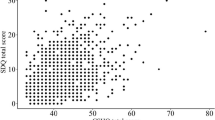Abstract
Objective
To describe and explore the association between proxy-reported sleep bruxism (SB) and quality of life (QoL) in a population of Colombian children belonging to different social layers.
Methods
The parents of 1556, 6–13-year-old school children, were administered the Pediatric Inventory of Quality of Life (PedsQL4.0™) and an evaluation of their sociodemographic and socioeconomic conditions. Associations between such proxy-reported, viz., “possible” SB and QoL features were assessed by means of the linear-by-linear association test on the overall sample and for distinct socioeconomic groups.
Results
No significant associations were shown between proxy-reported sleep bruxism and the total and domain PedsQL scores, with the exception of a weak correlation with the School Functioning Score. As for the specific QoL items, only two variables of the Emotional Functioning Scale of the PedsQL4.0 (i.e., “feeling afraid or scared” and “trouble sleeping”) and a feature of the School Functioning Scale (i.e., “forgetting things”) were weakly correlated with SB, with correlation coefficients ranging from 0.092 to 0.119. Considering the different socioeconomic groups, no associations were found in the low layer. In the medium socioeconomic group, a significant association was pointed out with one emotional functioning aspect, while in the high layer an association was found with two emotional features and three school functioning variables.
Conclusion
The results pointed out only a few associations between proxy-reported SB and the emotional and school functioning aspects of children’s quality of life, both in the total sample as well as in children belonging to medium and high socioeconomic status, while no associations were found with physical health and social functioning domains.
Clinical relevance
This article gives information to help clinicians evaluating the QoL, sociodemographic, and socioeconomic characteristics in children with possible sleep bruxism.
Similar content being viewed by others
References
Lobbezoo F, Ahlberg J, Glaros AG, Kato T, Koyano K, Lavigne GJ, et al. (2013) Bruxism defined and graded: an international consensus. J Oral Rehabil 40:2–4
Paesani DA, Lobbezoo F, Gelos C, Guarda-Nardini L, Ahlberg J, Manfredini D (2013) Correlation between self-reported and clinically based diagnoses of bruxism in temporomandibular disorders patients. J Oral Rehabil 40:803–839
Manfredini D, Winocur E, Guarda-Nardini L, Paesani D, Lobbezoo F (2013) Epidemiology of bruxism in adults: a systematic review of the literature. J Orofac Pain 27:99–110
Manfredini D, Restrepo C, Diaz-Serrano K, Winocur E, Lobbezoo F (2013) Prevalence of sleep bruxism in children: a systematic review of the literature. J Oral Rehabil 40:631–642
Ohayon MM, Li KK, Guilleminault C (2001) Risk factors for sleep bruxism in the general population. Chest 119:53–61
Dao TT, Lund JP, Lavigne GJ (1994) Comparison of pain and quality of life in bruxers and patients with myofascial pain of the masticatory muscles. J Orofac Pain 8:350–356
Manfredini D, Lobbezoo F (2009) Role of psychosocial factors in the etiology of bruxism. J Orofac Pain 23:153–166
The WHOQOL group (1994) Int J Ment Health 23:24–56
Rajmil L, López AR, López-Aguilà S, Alonso J (2013) Parent-child agreement on health-related quality of life (HRQOL): a longitudinal study. Health Qual Life Outcomes 11:101–110
Svedberg P, Eriksson M, Boman E (2013) Associations between scores of psychosomatic health symptoms and health-related quality of life in children and adolescents. Health Qual Life Outcomes 11:176–183
Serra-Negra JM, Paiva SM, Seabra AP, Dorella C, Lemos BF, Pordeus IA (2010) Prevalence of sleep bruxism in a group of Brazilian schoolchildren. Eur Arch Paediatr Dent 11:192–195
Laberge L, Tremblay RE, Vitaro F, Montplaisir J (2000) Development of parasomnias from childhood to early adolescence. Pediatrics 106:67–74
Insana SP, Gozal D, McNeil DW, Montgomery-Downs HE (2013) Community based study of sleep bruxism during early childhood. Sleep Med 14:183–188
Serra-Negra JM, Ramos-Jorge ML, Flores-Mendoza CE, Paiva SM, Pordeus IA (2009) Influence of psychosocial factors on the development of sleep bruxism among children. Int J Paediatr Dent 19:309–317
Lam MH, Zhang J, Li AM, Wing YK (2011) A community study of sleep bruxism in Hong Kong children: association with comorbid sleep disorders and neurobehavioral consequences. Sleep Med 12:641–645
Restrepo CC, Vásquez LM, Alvarez M, Valencia I (2008) Personality traits and temporomandibular disorders in a group of children with bruxing behaviour. J Oral Rehabil 35:585–593
Rossi D, Manfredini D (2013) Family and school environmental predictors of sleep bruxism in children. J Orofac Pain 27:135–141
Castelo PM, Barbosa TS, Gavião MB 2010 Quality of life evaluation of children with sleep bruxism. BMC Oral Health 10:16–22
Varni JW, Seid M, Kurtin PS (2001) PedsQL 4.0: reliability and validity of the pediatric quality of life inventory version 4.0 generic core scales in healthy and patient populations. Med Care 39:800–812
Owens JA, Spirito A, McGuinn M (2000) The Children’s sleep habits questionnaire (CSHQ): psychometric properties of a survey instrument for school-aged children. Sleep 23(8):1043–1051
Chen YL, Gau SS (2016) Sleep problems and internet addiction among children and adolescents: a longitudinal study. J Sleep Res. doi:10.1111/jsr.12388.
Sakaguchi K, Yagi T, Maeda A, Nagayama K, Uehara S, Saito-Sakoguchi Y, Kanematsu K, Miyawaki S (2014) Association of problem behavior with sleep problems and gastroesophageal reflux symptoms. Pediatr Int 56:24–30
De Oliveira MT, Bittencourt ST, Marcon K, Destro S, Pereira JR 2015 Sleep bruxism and anxiety level in children. Braz Oral Res 2015; 29.
Renner AC, da Silva AA, Rodriguez JD, Simões VM, Barbieri MA, Bettiol H, Thomaz EB, Saraiva Mda C (2012) Are mental health problems and depression associated with bruxism in children? Community Dent Oral Epidemiol 40:277–287
Acknowledgments
This investigation was fully financed by Universidad CES.
Author information
Authors and Affiliations
Corresponding author
Ethics declarations
This investigation was approved by the ethics committee of Universidad CES (files 133–44-1), and the children’s parents gave their written informed consent to participate in the study.
Conflict of interest
The authors declare that they have no conflict of interest.
Rights and permissions
About this article
Cite this article
Manfredini, D., Lobbezoo, F., Giancristofaro, R.A. et al. Association between proxy-reported sleep bruxism and quality of life aspects in Colombian children of different social layers. Clin Oral Invest 21, 1351–1358 (2017). https://doi.org/10.1007/s00784-016-1901-5
Received:
Accepted:
Published:
Issue Date:
DOI: https://doi.org/10.1007/s00784-016-1901-5




